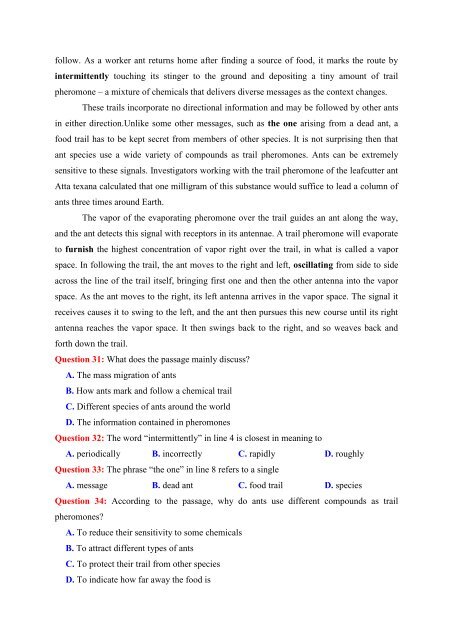Bộ đề thi thử THPTQG năm 2018 - Môn Tiếng Anh - 11 ĐỀ + ĐÁP ÁN - GV Nguyễn Phương - Hoc24h
https://app.box.com/s/94z9bdswkqqzgjyiz0qq8wl2qtk4nygj
https://app.box.com/s/94z9bdswkqqzgjyiz0qq8wl2qtk4nygj
Create successful ePaper yourself
Turn your PDF publications into a flip-book with our unique Google optimized e-Paper software.
follow. As a worker ant returns home after finding a source of food, it marks the route by<br />
intermittently touching its stinger to the ground and depositing a tiny amount of trail<br />
pheromone – a mixture of chemicals that delivers diverse messages as the context changes.<br />
These trails incorporate no directional information and may be followed by other ants<br />
in either direction.Unlike some other messages, such as the one arising from a dead ant, a<br />
food trail has to be kept secret from members of other species. It is not surprising then that<br />
ant species use a wide variety of compounds as trail pheromones. Ants can be extremely<br />
sensitive to these signals. Investigators working with the trail pheromone of the leafcutter ant<br />
Atta texana calculated that one milligram of <strong>thi</strong>s substance would suffice to lead a column of<br />
ants three times around Earth.<br />
The vapor of the evaporating pheromone over the trail guides an ant along the way,<br />
and the ant detects <strong>thi</strong>s signal with receptors in its antennae. A trail pheromone will evaporate<br />
to furnish the highest concentration of vapor right over the trail, in what is called a vapor<br />
space. In following the trail, the ant moves to the right and left, oscillating from side to side<br />
across the line of the trail itself, bringing first one and then the other antenna into the vapor<br />
space. As the ant moves to the right, its left antenna arrives in the vapor space. The signal it<br />
receives causes it to swing to the left, and the ant then pursues <strong>thi</strong>s new course until its right<br />
antenna reaches the vapor space. It then swings back to the right, and so weaves back and<br />
forth down the trail.<br />
Question 31: What does the passage mainly discuss?<br />
A. The mass migration of ants<br />
B. How ants mark and follow a chemical trail<br />
C. Different species of ants around the world<br />
D. The information contained in pheromones<br />
Question 32: The word “intermittently” in line 4 is closest in meaning to<br />
A. periodically B. incorrectly C. rapidly D. roughly<br />
Question 33: The phrase “the one” in line 8 refers to a single<br />
A. message B. dead ant C. food trail D. species<br />
Question 34: According to the passage, why do ants use different compounds as trail<br />
pheromones?<br />
A. To reduce their sensitivity to some chemicals<br />
B. To attract different types of ants<br />
C. To protect their trail from other species<br />
D. To indicate how far away the food is


















